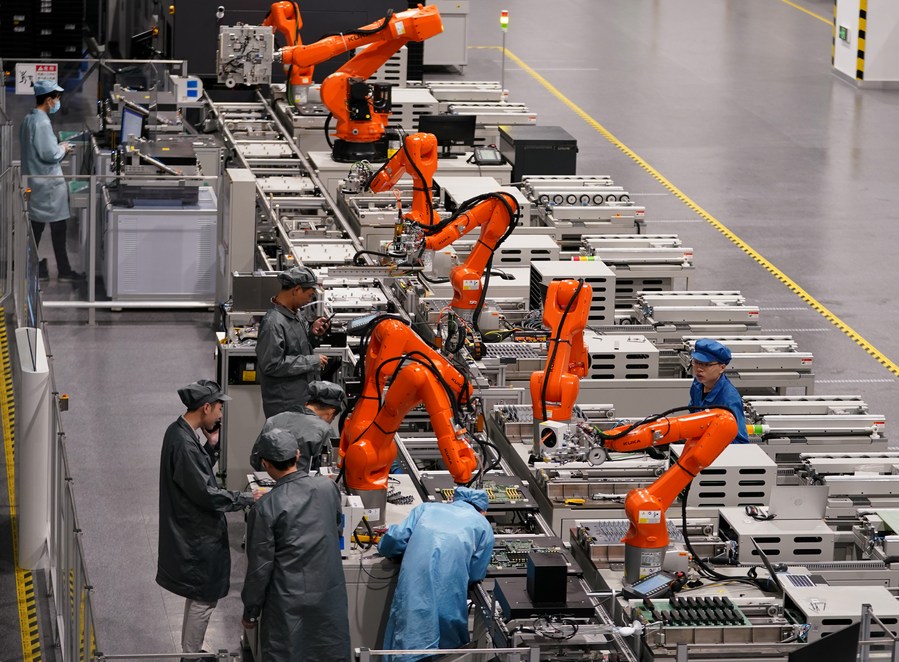Going Green and Smart

China’s experience in strategy formulation, policy design, R&D, resource allocation, and social mobilization can help many countries advance their green moves.
Two sets of energy data from China have received widespread attention recently: the share of renewable energy in China’s total installed power generation capacity climbed to 53.8 percent in the first half of this year, after surpassing thermal power’s share last year; and in July, China’s new-energy vehicles outsold fuel-powered passenger cars on a monthly basis for the first time. The two breakthroughs have once again brought China’s push for green transformation to the fore.
The erratic weather during the Paris Olympics, marked by blistering heat, was a matter of much discussion. Extreme heat was a challenge for both athletes and spectators. Citing data from CarbonPlan, a climate science and analytics-focused nonprofit, a CNN article warned that by 2050 most of the world will be too hot to hold the Olympics.
It’s a global consensus to mitigate the global warming, mainly caused by greenhouse gases. Green and low-carbon energy transformation has become the globally recognized way to achieve sustainable development. The third plenary session of the 20th Central Committee of the Communist Party of China (CPC) convened in July mapped out China’s plan to ramp up green transition in all areas of economic and social development. It includes developing green and low-carbon industries, improving incentive mechanisms for eco-friendly consumer spending, and improving the systems for total resource consumption control and comprehensive resource conservation, as well as the system for recycling waste and used materials. Notably, new systems will be established for carbon emission statistics and accounting, carbon labeling and certification, as well as for managing carbon footprints.
Recently, a set of guidelines were issued by the CPC Central Committee and the State Council, providing a timetable and blueprint for the green transition. It emphasizes integrating green industries with artificial intelligence (AI), big data, cloud computing, and Industrial Internet to promote coordinated digital and green transition.
In many traditional industries in China, smart technologies are fueling the green shift. Robots are used to unload and sort materials, drones are used in agriculture, and automated systems powered by 5G and the Internet of Things run production lines. For example, in Henan Province in central China, a representative company, Zhengzhou Coal Mining Machinery, has digitized the entire production process, doubling efficiency and increasing space for use by 50 percent. Wang Yongqiang, deputy general manager of the company, said their digital factory is now key to low-carbon, smart and efficient growth, according to a Xinhua report.

Meanwhile, humanoid robots also begin to flex their smart muscles to turbocharge the country’s sustainable growth. According to an industrial report by industrial giant UBTECH and its partners, China’s market size of humanoid robots will reach RMB 2.76 billion in 2024 and is expected to reach RMB 75 billion by 2029, taking up about a third of the global total.
Insiders ascribe the booming development to a nurturing ecosystem, including a well-developed high-end manufacturing sector, a burgeoning AI market and a wide range of application scenarios. China not only has the most comprehensive industrial system in the world, it is also the largest market for robotics applications. E-Town, located in the suburb of Beijing, is home to over 110 robotics companies, forming an industrial chain covering core components, complete machines, and applications.
Four years after China’s commitment to peak carbon emissions by 2030 and achieve carbon neutrality by 2060, there is remarkable progress in its low-carbon development. According to the International Energy Agency’s Renewables 2023 report, in 2023, China alone commissioned as much solar PV as the entire world did in 2022. China’s wind and photovoltaic products have been exported to more than 200 countries and regions, enabling the use of clean and affordable renewable energy.
In 2022, China’s renewable energy power generation was equivalent to the reduction of 2.26 billion tons of carbon dioxide emissions; the wind power and photovoltaic products it exported helped other countries reduce carbon dioxide emissions by about 573 million tons. The two together accounted for about 41 percent of global carbon emission reductions in that same period. Former UN Under-Secretary-General Erik Solheim called China an indispensable force in the global green transformation.
China has become a pacesetter in global green transformation. By making its fleets of affordable electric vehicles (EVs), solar photovoltaic panels and wind turbines available in many other countries, it is helping them to quicken their green shift. However, due to geopolitical reasons, some major Western countries are risking the green transition by levying high tariffs on Chinese EVs. It has led to the West’s own media casting doubts on their governments’ decision. “The global demand for renewable energy is surging; so why make solar panels, wind turbines and EVs dearer for Western consumers?” Jeffrey Frankel, a professor of capital formation and growth at Harvard University, asked in a recent article published in The Guardian.
China is undergoing an unprecedented economic and social green transformation. Its experience in strategy formulation, policy design, R&D, resource allocation, and social mobilization can help many countries advance their green moves. As some international observers have pointed out, China’s green manufacturing capacity is a boon to the world.
 Facebook
Facebook
 Twitter
Twitter
 Linkedin
Linkedin
 Google +
Google +










